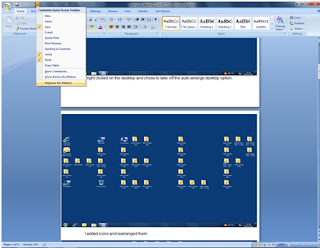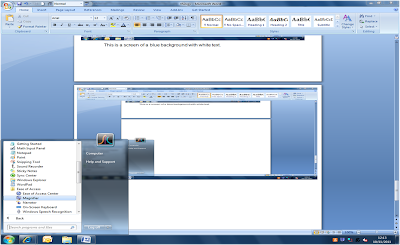Configure Desktop
This post was created to show you how to configure a desktop to suit a person with a visual disability. Many different options and settings can be changed to suit a person and in this tutorial i shall explore icon resizing, rearranging, colour manipulation, QAT customisation, gui and wimp interfaces and accessibility programs such as narrator and magnifier.
Icon resizing and re-arranging.
This is a screenshot of a desktop without any alterations or modifications designed for accessibility. It is what a user should see as soon as they log onto their computer unless they have altered the settings.
In this image, i am turning off the Auto Arrange feature.
The helpfulness of turning off auto arrange is only to customise icon location on your screen to suit yourself.
After turning off the Auto Arrange feature you can move and place the different icons on your page to suit you rather than the order that the computer sets them to.
This screen shows the icons at a large size.
This would help anybody who has problems with seeing icons.
I resized these icons to large in order to made them easier to see for people with bad eyesight.
Minimising the Ribbon

I also turned off the ribbon as shown on left. I turned off the ribbon by accessing the dropdown menu in the top left corner as shown.
This is an image of my document after removing the ribbon. I would often remove the ribbon in a document with the aim of increasing the amount of the document i could see. I also would remove the ribbon if I felt that the window was too cluttered.
QAT customisation
In this picture I am selecting the "more commands" option in the drop down menu next to the Quick Access Toolbar (QAT).
Within this menu i am selecting extra commands to go onto my (QAT) Quick Access Toolbar. i would use the quick access toolbar to save myself time when editting and creating documents.
The Quick Access Toolbar in this image contains extra icons such as spelling and grammar and paragraphing.
The Quick Access Toolbar would be used by people who have trouble searching for separate commands and actions within the program. An example of this would be a person who wishes to do nothing more than write a document, spell check it and then print it. You would set up a few Quick Access Toolbar options for them to help them.
Colour customisation
This image features a blue background with white text.
this may be helpful for people who get eye strain from a white background.
Accessibility programs - Magnifier
This is a picture of me entering the accessories menu of my computer.

This picture shows me highlighting and opening Narrator.
These two pictures display me opening the magnifier program for use in viewing programs closer up. Magnifier is useful for people who have problems seeing their screen.
There are many ways in which you can use magnifier to increase the size and visibility of text and images on your desktop.
Here are the three ways of using Magnifier.
This is the "Full-Screen" mode of Magnifier.
This is a full-screen screenshot without any resizing or image editing.
It is one of the ways you can use magnifier to see your screen more clearly.
I would advise people who have difficulty seeing icons in general to use this setting.
In this screenshot, I am using a lens magnifier.
It has its own advantages over fullscreen magnifier where you can see the entire screen and hover your mouse over what you want to magnify.
It offers the user much more control.
I would advise its use to people who have moderate visual problems and can recognise most icons on their screen
This is the final mode which you can use Magnifier.
It is known as the "Docked" Magnifier.
It features a window at the top of your desktop that magnifies whatever your mouse is hovering over.
This option can be helpful as it does nothing to what surrounds the mouse and can be used optionally rather than having the entire screen magnified.
I would advise this mode of Magnifier to people who only periodically need to magnify text of words they find unreadable, too small or illegible.
Accessibility programs - Narrator
This is an image of me opening Narrator in the Ease of Access section of my Accessories.
Narrator is a program that reads out everything you select or hover your mouse over for anyone who does not like using magnifier or who cannot use magnifier due to eye strain.
In this image i am configuring Narrator.
I can set the voice to other voices and set the speed, volume and pitch of the Narrator.
You can also choose the narrator to echo keystrokes and announce system messages.
You would want to edit these options to avoid unnecessary announcements or speech.
I would offer Narrator as a program to use for people who find using Magnifier or similar programs tedious or annoying.
Other programs to help the Visually impaired
There are also many more different programs and types of programs that pertain to the same task as magnifier and narrator such as Supernova Technology.
Products such as this should be used by people who find that Magnifier and Narrator softwares do not provide enough usability within their computer.
Thank you for reading!













